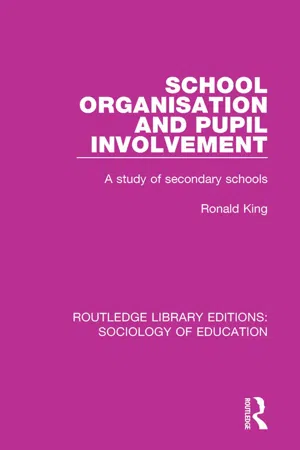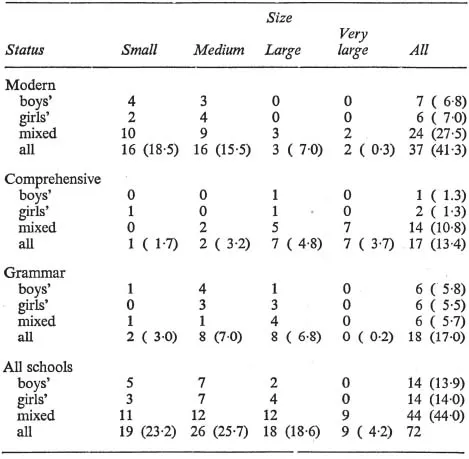
This is a test
- 268 pages
- English
- ePUB (mobile friendly)
- Available on iOS & Android
eBook - ePub
Book details
Book preview
Table of contents
Citations
About This Book
First published in 1973, this book is based on research carried about by Ronald King on integral parts of school organisation, including the assembly, uniform, rewards and punishments, games and out-of-school activities, curriculum, prefectorial system and school councils, in a sample of seventy-two schools. It measures and explores the level of pupils' involvement in the school, in terms in their evaluations and effective dispositions, in relation to pupil age, sex and social background.
This book will be a valuable resource for those studying the sociology and history of education, as well as educational research and school organisation.
Frequently asked questions
At the moment all of our mobile-responsive ePub books are available to download via the app. Most of our PDFs are also available to download and we're working on making the final remaining ones downloadable now. Learn more here.
Both plans give you full access to the library and all of Perlego’s features. The only differences are the price and subscription period: With the annual plan you’ll save around 30% compared to 12 months on the monthly plan.
We are an online textbook subscription service, where you can get access to an entire online library for less than the price of a single book per month. With over 1 million books across 1000+ topics, we’ve got you covered! Learn more here.
Look out for the read-aloud symbol on your next book to see if you can listen to it. The read-aloud tool reads text aloud for you, highlighting the text as it is being read. You can pause it, speed it up and slow it down. Learn more here.
Yes, you can access School Organisation and Pupil Involvement by Ronald King in PDF and/or ePUB format, as well as other popular books in Education & Education General. We have over one million books available in our catalogue for you to explore.
Information
1 The approach
The Introduction discussed the three basic questions which the chapters that follow this one attempt to answer. This chapter outlines how the information was obtained and treated in order to provide those answers, and does so under headings representing the three questions. In each case the methods used to obtain the data are described in outline and then, in more detail, the conceptual scheme used in the treatment of the data.
A more detailed account of some aspects of the sampling and methodology is given in Appendix A, and details of the statistical analysis in Appendix B.
The organisation of the school
The schools’ survey
The purpose of the schools’ survey was to obtain data concerning the organisation of pupil learning and behaviour.
The sample consisted of seventy-two schools which were reasonably representative of the national (England and Wales) distribution of schools by size, sex composition and status (Table 1). The schools were drawn from seven local authority areas in the south-west of England. Between them they serve a city with half a million population, one of a quarter of a million, two towns of 100,000, many smaller towns, and a large rural area.
Four important methods were used in the survey:
1. A self-completion questionnaire for the headteacher or his delegate.
2. The content analysis of documents provided by the school.
3. Direct, non-participant observations in the school.
4. Interview(s) with the headteacher and other staff.
These four methods were used to collect mainly two kinds of information concerned respectively with the how and the why of the situation. First, data concerning the organisation of all aspects of the school directly affecting the pupils, including learning groups, curriculum, games, out-of-school activities, assessments, uniform, House, prefectorial and pastoral care systems. Second, headteachers were asked to explain their purpose in choosing to organise the school in the way they did. In addition, information about the social characteristics of the pupils was obtained.
TABLE 1 Schools’ survey sample—actual and ideal numbers

Notes. Small, < 400; medium, 401–600; large, 601–1,000; very large, > 1,000.
The grammar sample actually consisted of sixteen grammar schools, one boys’ technical school, and one girls’ selective secondary school not designated a grammar school, both de facto grammar schools. Figures not in brackets show actual numbers of schools; those in brackets the ideal numbers by the 1969 statistics (see Appendix A). Fifteen of the comprehensives were of the 11–18 type; one was for 11–15 and the other for 14–18.
The scheme of analysis
The survey provided over one thousand items of data about the organisation of each of the seventy-two schools. Each item was classified using a scheme of analysis which views the organisation of the school as complex and multivariate. It is a truism that the organisation of schools is widely variable. The scheme is an attempt to analyse this phenomenon by posing three important sets of ways in which school organisation may vary. These organisational variables are:
(a) Activity variables
(b) Structural variables
(c) Contextual variables
(a) Activity variables The two principal activities of a school are considered to be the transmission of educational knowledge and the transmission of modes of approved behaviour. The term instrumental is used to describe those processes used in the transmission of knowledge, and the term expressive for those used in the transmission of approved modes of behaviour. Schools may vary in the knowledge and modes of approved behaviour they transmit, and in the activities used in their transmission.
A further distinction is made between the process or activity of transmission, and the judgments, including the use of rewards and punishments, of the performance of the pupils in the assimilation of what is transmitted. Thus there are four basic types of activity:
1. Instrumental activities, e.g. doing homework.
2. Instrumental performance, e.g. marks collected for homework.
3. Expressive activities, e.g. entering school when the bell rings.
4. Expressive performance, e.g. detention for lateness.
The other officially recognised activities of the school are classified according to their association with the prefectorial, House, pastoral care and games systems, and with out-of-school activities, although it is recognised that often these may also be classified as either instrumental or expressive, as when, for example, the House system is used as a basis for academic competition.
(b) Structural variables Schools vary in the way they structure, or in the ordinary sense, organise, these different kinds of activities. Four such structural variables are used in this approach; standardisation, formalisation, specialisation and ritualisation.
Standardisation, in the form of rules, routines and set procedures is a basic aspect of all organisations. It establishes where the organisation ends and the rest of the world begins. Homework extends school into the home and into the night. A ban on eating on the way home brings school into the street and out of ‘school hours’.
Many of the activities that occur in schools are not officially standardised, and therefore are not strictly speaking organisational. Much of what goes on in playgrounds and staffrooms is neither planned nor deliberately structured. More importantly, much of what goes on in the classroom is also extra-organisational, because teachers in British schools are generally allowed a great deal of autonomy in the teaching situation. This is an aspect of the professional nature of the teacher’s role which is achieved through specific training and qualifications rather than by being employed in a particular school. Although some processes may be standardised throughout the school, much of the learning is planned and structured by individual teachers with a degree of independence from the school context. The school may standardise pupil behaviour, but individual teachers have their own standards and their own personalised techniques of control.
Formalisation refers to the organisational use of paper in such forms as lists, written rules, records and memoranda. The timetable is an excellent example of formalisation in the school.
The specialisation of activities among pupils is usually made on the basis of three salient pupil characteristics; age, sex and imputed ability. Pupils of different ages, sexes and imputed abilities may be taught different things, expected to behave in different ways, may be controlled, punished and rewarded in different ways.
The House and prefectorial systems may also be considered to be the basis of other principles of specialisation.
Ritualisation refers to the use of symbols. A symbol is simply defined as a thing representing or typifying something else. Symbols in schools have two forms; ceremonials, as in the school assembly, and emblems, tangible symbols such as plaques and badges.
(c) Contextual variables The activities of schools and the organisational structures associated with them occur in situations or contexts which may vary from one school to another, and may affect the activities and their organisation. These contextual variables may be broadly classified as being either internal or external, without implying that a definite boundary exists between the school and other social systems.
Internal contextual variables are of two kinds; those concerned with resources, and those that condition the nature of those resources.
The most important resources of a school are its pupils. Variations in their social characteristics give rise to the following variables:
1. Age composition
2. Sex composition
3. Ability composition
4. Social composition
The size of the school in terms of the number of pupils, is another important resource variable, as are the physical plant and material provision of the school. (Teachers, too, are resources that vary in number and in their social characteristics.)
The important conditioning variables include:
1. The administrative status of the school, which may vary in terms of financial control (maintained, voluntary-aided, etc.), religious affiliation, sex composition, and selectivity (modern, grammar, comprehensive, etc.)
2. The charter and articles of government
3. The school’s recent social history
4. The school’s ideology
External contextual variables are more difficult to define. Strictly speaking the external context of the school consists of the total social system, and it is therefore difficult to know which of the enormous number of things which may vary outside the school may be related to what happens inside the school. (For a review, see Eggleston (1967).) The following may be important:
1. The social characteristics of the local area, including its social class composition and density of population.
2. The local occupational structure.
3. The local educational structure, including provision of further education and relationships between schools in terms of co-operation and competition.
4. The national educational structure, inc...
Table of contents
- Cover
- Half Title
- Title Page
- Copyright Page
- Table of Contents
- Acknowledgments
- Introduction
- 1 The approach
- 2 General involvement in school
- 3 The expressive order
- 4 School rituals
- 5 The House system and pastoral care
- 6 Games and out-of-school activities
- 7 The instrumental order
- 8 Ability-specialisation
- 9 Age-specialisation
- 10 Authority relationships
- 11 Sex-specialisation
- 12 School organisation and pupil involvement
- Appendix A Some notes on the samples and methodology
- Appendix B A note on the methods of analysis
- Appendix C Additional tables
- Bibliography
- Index